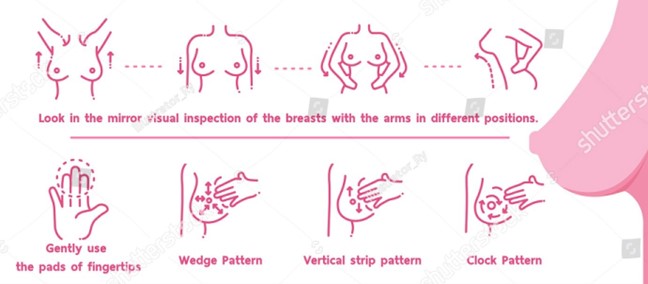When assessing the breast, the nurse would teach the patient to palpate which of the following areas?
Upper outer quadrant
Lower inner quadrant
Upper inner quadrant
Tail of spence
Correct Answer : A,B,C
The nurses would teach the patient to palpate all four quadrants of the breast, including the upper outer quadrant, lower inner quadrant, and upper inner quadrant, as well as the tail of Spence, which is the extension of breast tissue into the axilla (armpit). It's important for the patient to be familiar with their own breast tissue and report any changes or abnormalities to their healthcare provider.

Nursing Test Bank
Naxlex Comprehensive Predictor Exams
Related Questions
Correct Answer is B
Explanation
Objective data refers to measurable and observable information gathered during a patient assessment, such as physical signs, laboratory values, and other measurable data. In this case, the loss of hair on bilateral legs can be observed and measured, making it an objective finding. Options a, c, and d are all subjective data as they rely on the patient's report or description of their symptoms, which cannot be directly observed or measured.
Correct Answer is D
Explanation
This response demonstrates respect for the client's religious beliefs and a willingness to work with the client to meet their needs. It also opens up a dialogue between the nurse and the client to develop a plan of care that is consistent with the client's beliefs and values.
Option a, "Fasting is harmful to your body," is not an appropriate response as it does not respect the client's religious beliefs and may be perceived as insensitive or disrespectful.
Option b, "You must have food during times of illness," may be accurate in some situations, but it is not relevant to the client's request to fast during Ramadan.
Option c, "I will let your healthcare provider know that you need to be discharged," is not an appropriate response as it does not address the client's request to fast during Ramadan and may be perceived as dismissive or unhelpful.
Whether you are a student looking to ace your exams or a practicing nurse seeking to enhance your expertise , our nursing education contents will empower you with the confidence and competence to make a difference in the lives of patients and become a respected leader in the healthcare field.
Visit Naxlex, invest in your future and unlock endless possibilities with our unparalleled nursing education contents today
Report Wrong Answer on the Current Question
Do you disagree with the answer? If yes, what is your expected answer? Explain.
Kindly be descriptive with the issue you are facing.
